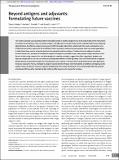| dc.contributor.author | Moyer, Tyson | |
| dc.contributor.author | Zmolek, Andrew Charles | |
| dc.contributor.author | Irvine, Darrell J | |
| dc.date.accessioned | 2017-04-18T20:03:05Z | |
| dc.date.available | 2017-04-18T20:03:05Z | |
| dc.date.issued | 2016-03 | |
| dc.identifier.issn | 0021-9738 | |
| dc.identifier.issn | 1558-8238 | |
| dc.identifier.uri | http://hdl.handle.net/1721.1/108232 | |
| dc.description.abstract | The need to optimize vaccine potency while minimizing toxicity in healthy recipients has motivated studies of the formulation of vaccines to control how, when, and where antigens and adjuvants encounter immune cells and other cells/tissues following administration. An effective subunit vaccine must traffic to lymph nodes (LNs), activate both the innate and adaptive arms of the immune system, and persist for a sufficient time to promote a mature immune response. Here, we review approaches to tailor these three aspects of vaccine function through optimized formulations. Traditional vaccine adjuvants activate innate immune cells, promote cell-mediated transport of antigen to lymphoid tissues, and promote antigen retention in LNs. Recent studies using nanoparticles and other lymphatic-targeting strategies suggest that direct targeting of antigens and adjuvant compounds to LNs can also enhance vaccine potency without sacrificing safety. The use of formulations to regulate biodistribution and promote antigen and inflammatory cue co-uptake in immune cells may be important for next-generation molecular adjuvants. Finally, strategies to program vaccine kinetics through novel formulation and delivery strategies provide another means to enhance immune responses independent of the choice of adjuvant. These technologies offer the prospect of enhanced efficacy while maintaining high safety profiles necessary for successful vaccines. | en_US |
| dc.description.sponsorship | United States. National Institutes of Health (UM1AI100663) | en_US |
| dc.description.sponsorship | United States. National Institutes of Health (AI104715) | en_US |
| dc.description.sponsorship | United States. National Institutes of Health (AI091693) | en_US |
| dc.description.sponsorship | United States. National Institutes of Health (AI095109) | en_US |
| dc.description.sponsorship | Massachusetts Institute of Technology. Institute for Soldier Nanotechnologies (W911NF-13-D-0001) | en_US |
| dc.description.sponsorship | National Science Foundation (U.S.) (1122374) | en_US |
| dc.description.sponsorship | Ragon Institute of MGH, MIT and Harvard | en_US |
| dc.description.sponsorship | Bill & Melinda Gates Foundation | en_US |
| dc.description.sponsorship | V Foundation for Cancer Research | en_US |
| dc.description.sponsorship | David H. Koch Institute for Integrative Cancer Research at MIT. Bridge Project | en_US |
| dc.description.sponsorship | Dana-Farber/Harvard Cancer Center | en_US |
| dc.description.sponsorship | United States. Army Research Office | en_US |
| dc.description.sponsorship | National Science Foundation (U.S.). Graduate Research Fellowship Program (Grant 1122374) | en_US |
| dc.language.iso | en_US | |
| dc.publisher | American Society for Clinical Investigation | en_US |
| dc.relation.isversionof | http://dx.doi.org/10.1172/jci81083 | en_US |
| dc.rights | Article is made available in accordance with the publisher's policy and may be subject to US copyright law. Please refer to the publisher's site for terms of use. | en_US |
| dc.source | American Society for Clinical Investigation | en_US |
| dc.title | Beyond antigens and adjuvants: formulating future vaccines | en_US |
| dc.type | Article | en_US |
| dc.identifier.citation | Moyer, Tyson J., Andrew C. Zmolek, and Darrell J. Irvine. “Beyond Antigens and Adjuvants: Formulating Future Vaccines.” Journal of Clinical Investigation 126, no. 3 (March 1, 2016): 799–808. © 2016 American Society for Clinical Investigation | en_US |
| dc.contributor.department | Massachusetts Institute of Technology. Department of Biological Engineering | en_US |
| dc.contributor.department | Massachusetts Institute of Technology. Department of Chemical Engineering | en_US |
| dc.contributor.department | Massachusetts Institute of Technology. Department of Materials Science and Engineering | en_US |
| dc.contributor.department | Ragon Institute of MGH, MIT and Harvard | en_US |
| dc.contributor.department | Koch Institute for Integrative Cancer Research at MIT | en_US |
| dc.contributor.mitauthor | Moyer, Tyson | |
| dc.contributor.mitauthor | Zmolek, Andrew Charles | |
| dc.contributor.mitauthor | Irvine, Darrell J | |
| dc.relation.journal | Journal of Clinical Investigation | en_US |
| dc.eprint.version | Final published version | en_US |
| dc.type.uri | http://purl.org/eprint/type/JournalArticle | en_US |
| eprint.status | http://purl.org/eprint/status/PeerReviewed | en_US |
| dspace.orderedauthors | Moyer, Tyson J.; Zmolek, Andrew C.; Irvine, Darrell J. | en_US |
| dspace.embargo.terms | N | en_US |
| dc.identifier.orcid | https://orcid.org/0000-0002-0926-9642 | |
| dc.identifier.orcid | https://orcid.org/0000-0002-9166-3891 | |
| mit.license | PUBLISHER_POLICY | en_US |
